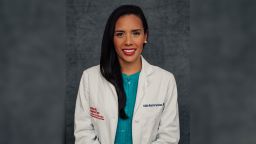Editor’s Note: Edith Bracho-Sanchez is a primary care pediatrician, director of pediatric telemedicine and assistant professor of pediatrics at Columbia University Irving Medical Center. She is also a member of the American Academy of Pediatrics. The views expressed in this commentary are her own. Read more opinion on CNN.
We all know that schools play a central and crucial role in the lives of children. But President Donald Trump, without clear plans to contain the coronavirus in communities where it is currently surging, has threatened to defund schools that don’t open up in the fall. This move would be detrimental to children, their parents and teachers, adding more fear and confusion during an already chaotic time. (As CNN’s Tami Luhby writes, the President can’t unilaterally cut current federal support of schools, but “could try to restrict some recent pandemic relief funding or refuse to sign future education grants and bailouts, and any reductions in federal funding would hit schools hard.”)

Our collective goal should be to reopen schools in a safe manner this fall. But the reopening of schools is exactly that – a goal – and one that is going to require work, preparation, flexibility, and collective action to be executed safely.
The preparations for a safe reopening must start with a comprehensive strategy to contain the virus in communities where it is currently surging, and – as health experts have said from the beginning of the pandemic–containment strategies must be widely and consistently adopted around the country if the virus is to stop spreading from one community to the next.
Teachers, students, and parents (and parents’ employers) will also need to remain as flexible as possible. Some schools may be able to reopen and then need to close if there is a resurgence of the virus, and some schools may choose to adopt hybrid models where students engage in in-person learning for part of the school week, and virtual learning for the rest.
As communities we must also ensure that all schools – not only those in wealthier districts – have the resources to safely reopen this fall. A failure to do so would further exacerbate disparities in education and would leave children in already vulnerable communities further behind their peers.
Science and facts, and not fear or threats, must guide our choices. Recent recommendations from the American Academy of Pediatrics for in-person reopening of schools in the are based on the documented benefits of school for children and their families, as well as the understanding that coronavirus is a very different disease in children than in adults. The data consistently show that children are less likely to be symptomatic from Covid-19 or to develop complications. Children also seem less likely to become infected with SARS-CoV2, the virus that causes Covid-19 when exposed.
And there is no question that school is good for children, not only for their education, but also for their development and their mental and physical health. It is also a place where many children receive health care provided by school nurses and physicians, receive nutritious meals and where abuse and neglect are often first detected.
Yet while the data are reassuring and the benefits of in-person school attendance are clear, children simply don’t exist in a vacuum: they need parents to drop them off and pick them up, teachers to teach them and babysitters–sometimes grandparents–to help. The list goes on. The risk of acquiring Covid-19 for adults seems to be greater from other adults than it is from children, and each of these adult-to-adult interactions increases the risk that they will be exposed to – and will ultimately contract–the virus that causes Covid-19.
Get our free weekly newsletter
It is unfair to ask parents to send their kids to school, and to ask teachers, many of whom have their own families, to show up to teach them, while the virus continues to surge in communities around the country. If we are serious about reopening schools everywhere, we must be serious about containing this virus first.
Now is the time for consistent and responsible messaging around face coverings. Now too is the time to improve testing availability and turnaround time and – most importantly– if we are to safely put children back to school, now is the time to invest in said schools, not to threaten their funding.





















